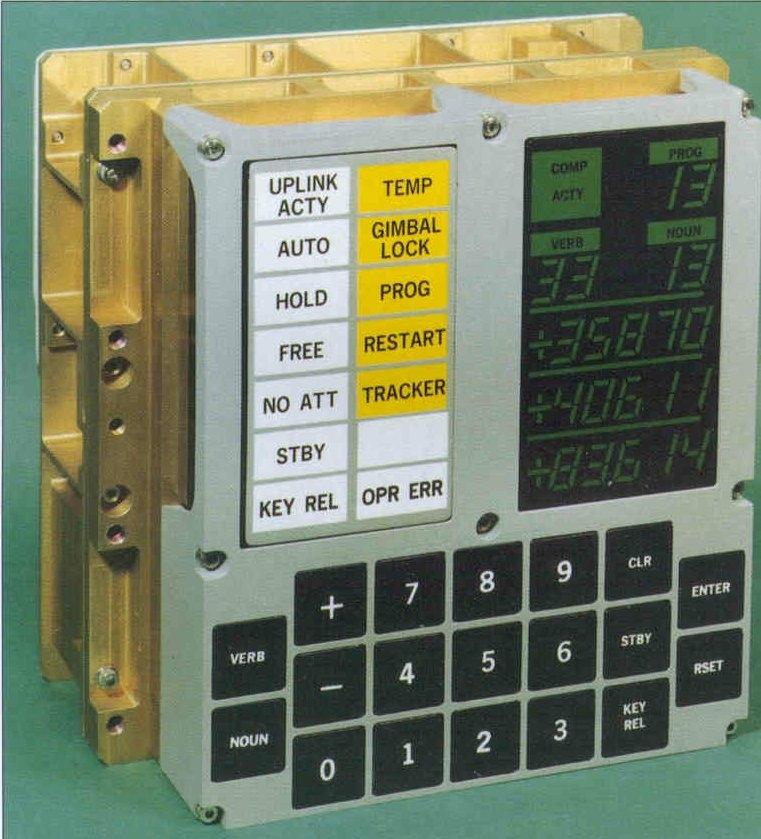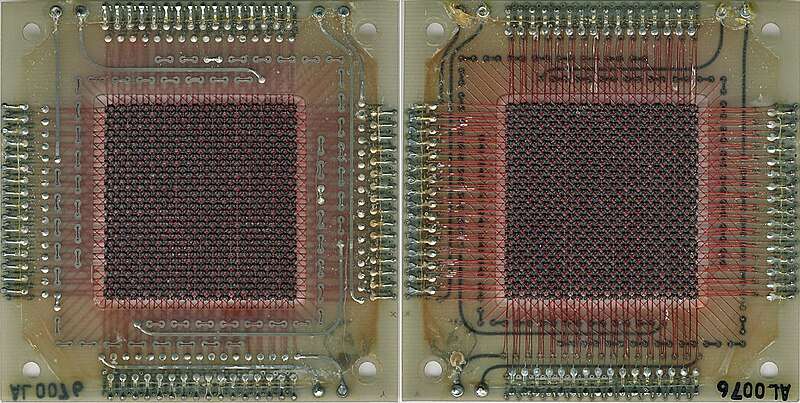In the spirit of the 40th anniversary of the moon landing and my own computer science background, I found a very interesting article ...
How powerful was the Apollo 11 computer?Take Intel's venerable 8086 for example -- you might know it better as "x86". Released in 1979, just a decade after Apollo 11's trip to the Moon, the 8086's cousin, the 8088, formed the basis for the IBM PC we all know and love. When the IBM PC "XT" was released in 1981, the lowest end configuration had 8 times more memory than Apollo's Guidance Computer -- 16k, vs the Apollo's 2k. The read-only storage of the AGC was 32k,
The IBM PC XT also ran at a dizzying clock speed of 4.077MHz. That's 0.004077 GHz. The Apollo's Guidance Computer was a snail-like 1.024 MHz in comparison, and it's external signaling was half that -- actually measured in Hz (1/1000th of 1 MHz, much as 1 MHz is 1/1000 of 1 GHz).
Internally, the 8086 had 8 16-bit registers available to work with -- for those not familiar with the internals of a processor, a register is much like the numbers you'd keep in your head while doing math, and "memory" is more like scratch paper where you write things down for later use. The 8086 could keep track of 8 of those, the Apollo Guidance Computer held just 4. (The AGC also had a host of other non-general purpose registers, ranging from 1 to 16 bits in width, but it's difficult to compare those with the architecture of the 8086)
It can get very geeky ... but some of you might be into that sort of thing.
Results 1 to 6 of 6
-
07-22-2009, 04:01 AM #1
 How powerful was the Apollo 11 computer?
How powerful was the Apollo 11 computer?
-
07-22-2009, 04:18 AM #2
Well I think multi tasking with one processor was not done, so they have a bunch of computers then on board = bulky and heavy
-
07-22-2009, 12:07 PM #3
The Apollo Guidance Computer's (AGC) ONLY interface was the DSKY (shorcut for "Display and Keyboard"). It was the ONLY way to enter data.

As you can see, there's NO QWERTY KEYBOARD! Which meant the astronauts had to MEMORIZE verb and noun combinations along with program numbers, to enable the computer to perform tasks.
Now, the Primary Guidance, Navigation and Control System (PGNCS or "Pings") and the Abort Guidance System (AGS pronounced as "Ags") was sort of capable of multitasking--Pings and Ags were two different computer systems, but their manner of working together had to be such that the other was able to be loaded up when it was needed by the lander for guidance. As you can see from the name itself, to land on the moon you obviously need Pings, but what happens if you needed to abort? You needed a computer that would guide the LM back to Mike Collins (Command Module), and this computer was the AGS.
Now during the Apollo 11 landing, both the Pings and the Ags were on at the same time, which was fine. However, Buzz insisted that the landing radar be on at the same time as well, and THAT proved to be a BAD move, because the memory-starved AGC could only handle landing data and when it started to feed itself the fast incoming radar altitude and velocity data, it started to CHOKE, (OVERLOAD!) leading to the famous...
"1202, we got a 1202 alarm!"
"1201, same type!"
...alarms, which almost aborted Apollo 11's landing.
Incidentally, I was a member of an Orbiter addon team called Project NASSP (later on, Project Apollo) back in 2003-2004.
Now, this team was divided into several groups. I worked with a group that mostly dealth with 3D graphics and textures for the simulation, but there was a team who actually managed to create a 70% functional simulated AGC and DSKY, shown here...

It had a very lengthy checkist, and you have to go through these checklists to remember what NOUN/VERB combinations and numerals you're supposed to enter, to start a particular program (i.e. TLi, landing, ascent, re-entry etc.).

It's still available from Sourceforge:
http://nassp.sourceforge.net/wiki/Main_Page
-RODIONLast edited by rodsky; 07-22-2009 at 07:32 PM.
-
07-22-2009, 02:43 PM #4
para sa mga computer geeks..
murag LGA sa Core i7 or PGA sa Athlon II... hehehe

A 1024-bit core memory module from the Apollo Guidance Computer (AGC). There are 1024 circular ceramic magnets, each one with three wires running through it. A memory bit is set or read by passing current through the wires and changing the polarity of a magnet. This module is approximately 3 inches square.
more from wiki's pages >> Apollo Guidance Computer
talk about creating an embedded system that can fly to the moon..
AGC Schematics
hope dili ni mamove to computer hardware. ^__^
-
07-22-2009, 03:02 PM #5
As you can see, there's NO QWERTY KEYBOARD! Which meant the astronauts had to MEMORIZE verb and noun combinations along with program numbers, to enable the computer to perform tasks.
grabe lisoda sad...
-
07-22-2009, 03:11 PM #6
this was also discussed on pcweenies.com, about the same day... trying to say n people right now dont appreciate speed and performance they way people appreciate it before...
Advertisement
Similar Threads |
|








